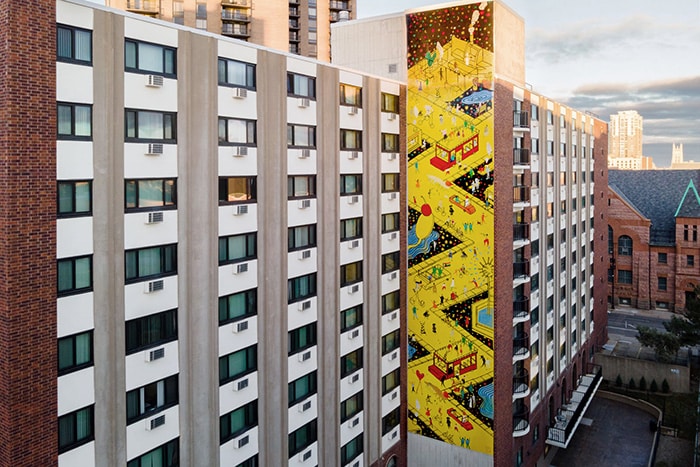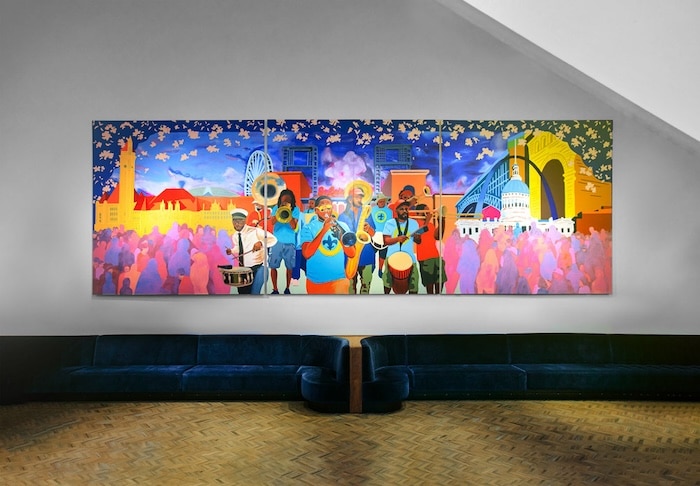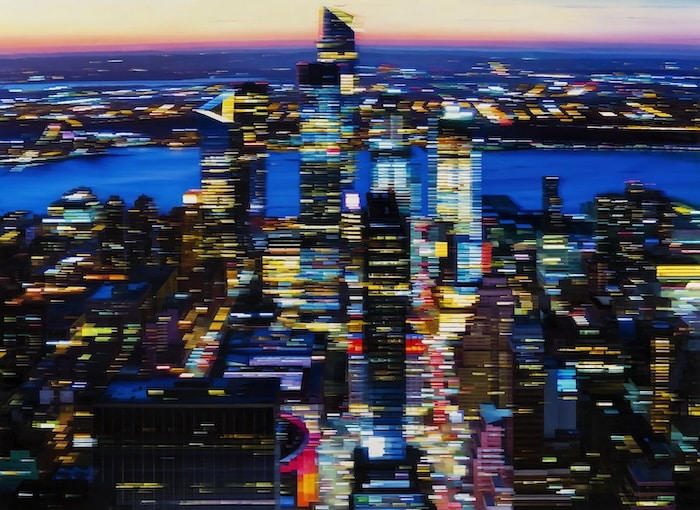Ancient Roman Frescos advertising a market’s wares, thoughtful quotidian scenes decorating an early 20th-century postal lobby, and the iconic art nouveau entrances of the Paris metro: corporate art has a long and storied history of adorning and innovating public spaces, and it’s for good reason. Humans have relied on art to beautify and create personal connections since the earliest cave drawings, but did you know that its true power actually runs much deeper?
Many companies are aware of the power of corporate art when it comes to establishing a strong brand identity, but what if the investment signals something more profound? What if investing in art not only benefits a business, but the surrounding community as well?
Leading professionals understand that it’s crucial to apply innovative thinking when addressing issues of social responsibility, and art can play a unique role when it comes to taking action. In fact, the emergence of corporate social responsibility (CSR) practices is changing business attitudes toward the arts, leading to a definitive win-win for businesses, communities, and independent creators.
So what, exactly, are we aiming to address, and how does corporate art function as a tool? From maximizing internal efficiency in a socially responsible way to addressing issues of culture and diversity, the importance of art in a corporate setting manifests in varied and astounding ways.
Advancing Community Priorities through Corporate Art
Curious to better understand the public value of the arts in King County, the Artsfund Social Impact of the Arts study wanted a deeper look at how the arts advance community priorities and positive results for both participants and non-participants. “With a primary focus on youth development and education, health and wellness, and neighborhood vitality, the study probes the potential for arts to influence more equitable outcomes”. Artsfund didn’t take any shortcuts: in fact, their report combines a county-wide public poll, a landscape scan of King County arts, cultural, and heritage nonprofits, a review of 150+ national research resources, and case studies of ten regional arts organizations.
The results are fascinating, as well as a call to action. We intrinsically value the arts in our lives – they “entertain, inspire, inform, and provoke us.” They also play a crucial role in invigorating communities and shaping regions, which help define an area’s identity while giving it importance and influencing the economy. However, the research also reveals an unfortunate disconnect between the undeniable value of the arts and the local understanding of their impact, which has the potential to threaten important programs while misleading decision-makers.
But instead of framing this scenario as all doom and gloom, perhaps it presents a crucial opportunity to learn and lead. Acknowledging that other cities around the world are successfully implementing arts-based strategies to influence economic, community, and social development, the study helped King County understand that to meet their most pressing challenges, “We will need to find a way to leverage and expand the powerful impacts of the arts so more people and communities can benefit.” Sometimes, we don’t need to fully understand how something works in order to give it another try – sometimes, we simply need a fresh new strategy and perspective.

Ryan Peltier’s jaw-dropping 14-story mural establishes a sense of place and pride while connecting an affordable housing community with its neighbors.
Investing in Community through Corporate Art
According to Culturehive, business funding for the arts comes primarily from two sources: marketing spend (like sponsorships), which results in a clear branding benefit, and from corporate community investment budgets. “Community investment is a distinct part of CSR (corporate social responsibility) and relates to a company’s commitment to the community via the contribution of finance and skills. Companies often use their community investment activities as a way of contributing to solving social problems.” These activities ultimately become a critical part of a company’s communication strategy and demonstrate a firm commitment to responsible corporate behavior.
And these commitments have long-term implications for both businesses and the communities they inhabit. The arts have historically been linked with lower crime rates and greater life satisfaction, which makes an area more desirable and, ultimately, more economically robust. Imagine a bustling new arts district on a forgotten stretch of main street: picture the quaint new cafes and farm-to-table restaurants. From offering new places to allow neighbors to mingle to creating new opportunities for budding entrepreneurs and employees, corporate art can play a critical role in growth and development.

Artist Quinn Briceño explains, “Saint Louisans have a lot of love for our community, despite its flaws,” and his mural for Neiman Marcus serves as a love letter to his dynamic community.
Using Corporate Art to Invigorate from the Inside
If you’re invested in contributing to positive change in your community, sometimes the best place to start is right at home. And, as Culturehive also reported, arts projects can present unique ways of engaging and even involving staff. “Involvement can improve the creativity of organizations and its people, can inspire innovation and new approaches to work, and provide informal ways for staff to engage with each other.” It may sound overly simplistic, but don’t we have a greater ability to provide a positive impact on the people we interact with from day to day?
A community is no better than the sum of its parts, and facilitating happier work environments with a greater sense of connection creates a strong foundation for something bigger. From a three-person mom and pop to the giants of Silicon Valley, no one’s potential should be undervalued.

Small details can have a major impact, and in the office at Manhattan Plaza, the dizzying works of Alexandra Pacula remind employees that the buzz of the city still surrounds them – even during office hours.
Learning and Growing through Corporate Art
A recent course at the Sotheby’s Institute of Art aimed to investigate the role of the art world in addressing issues of social responsibility, as well as how we might apply innovative thinking. “To work with social responsibility, museum, and gallery professionals are developing new strategies and applying innovative thinking to engage with contested notions of culture, identity, diversity, social justice, and climate change”. And these strategies are critical for businesses working with corporate art.
Social responsibility and art are interconnected by accountability issues, and in the current day, art isn’t just a way to differentiate your business; it’s critical to its survival. Sotheby’s elaborates on these core issues of accountability, including:
- Economic: Businesses must plan with efficiency, resilience, fair trade, and profitability/sustainability.
- Legal: Companies must adhere to rules, regulations, policies, procedures, and best practices.
- Ethical: Businesses must act responsibly and in the interests of general welfare – even when it’s not legally required.
- Philanthropy: Corporations should contribute directly to their communities and social projects, even when it’s not obligatory or unessential to their day-to-day operations.
- Environment: Thoughtful enterprises should care about conserving natural resources and reducing their environmental impact, and environmentally conscious and sustainable art activities or activations can be a way to facilitate that.
- Human Rights: Corporate art has the power to address imbalance and social injustice by redirecting the focus to diversity, equity, and inclusion.
From community-centered murals that celebrate the local culture to artfully illustrated advertisements scattered across the country, we’re openly surrounded by an abundance of corporate art – and perhaps that’s why we sometimes lose sight of its true value. But if we take a moment to dig a little deeper and open our eyes and hearts, a touching narrative of the best of humanity rises to the surface. For what are we without our neighbors? Perhaps we’d all be better off if we looked towards art to reconnect and rediscover what’s really important.
How do you think corporate art can reshape our communities and workplaces? Share your thoughts on the transformative power of art in fostering a more connected and socially responsible society.
